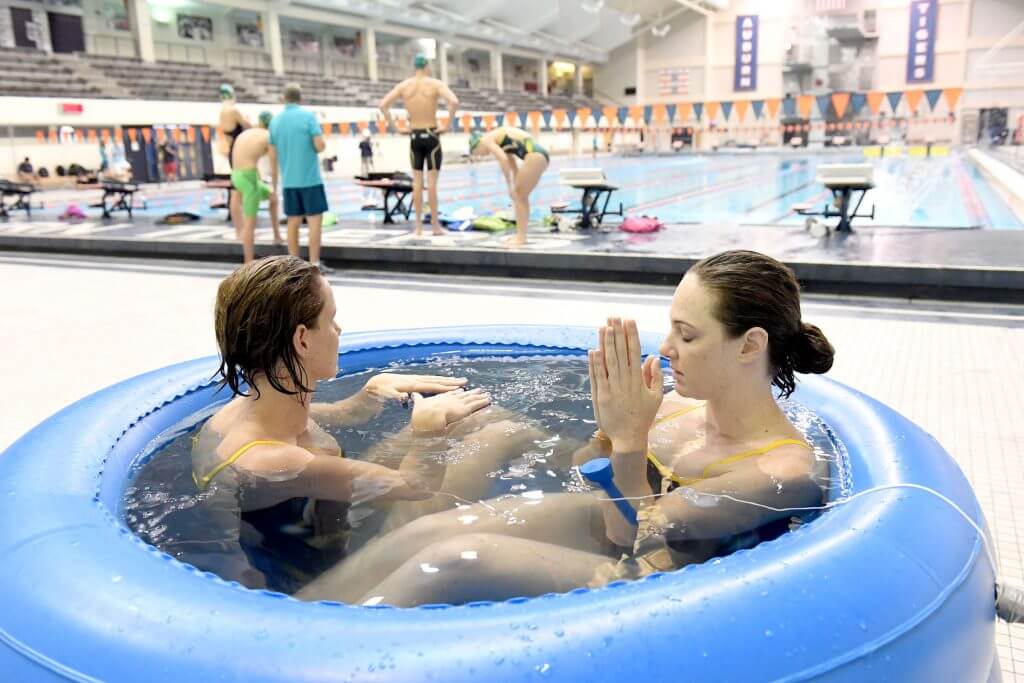Wellness Wednesday: Harnessing the Power of Ice Baths and Hot Tubs for Recovery

Wellness Wednesday: Harnessing the Power of Ice Baths and Hot Tubs for Recovery
In the demanding world of competitive swimming, the pursuit of peak performance is a constant goal for swimmers seeking to push past their limits. Amid the rigorous training and intense competitions, recovery becomes an important aspect of an athlete’s journey. Ice baths and hot tubs are as contrasting as it gets, yet they are complementary tools in the many types of recovery techniques, providing swimmers with therapeutic relief to enhance their recovery process.
Benefits of Ice Baths
Ice baths or Cold Water Immersion (CWI) are used by athletes to recover after tough workouts or in between periods of competition. Ice baths can be easily made. Some sort of large tub, like a bathtub, is filled with cold water and topped off with a large amount of ice. Ideally, the water should be about 12-15 degrees Celsius (53.6-59 degrees Fahrenheit), and the athlete should spend between 5-10 minutes in the ice bath.
Studies indicate that CWI could potentially alleviate Delayed Onset Muscle Soreness (DOMS) following intense exercise, according to the Journal of Strength and Conditioning Research. DOMS typically reaches its peak about 48 hours after strenuous exercise and may persist for up to 72 hours. While some individuals perceive DOMS as routine muscle soreness, for others, it can manifest as intense pain that hinders exercise for days afterward. CWI can also potentially lead to an improvement in sleep quality. However, it is important to note that CWI does not have the ability to undo damage to muscle tissue, increase red blood cell count, or speed up the synthesis process of protein into muscle tissue. Its most effective application lies in decreasing the discomfort and pain associated with muscle-damaging training and competition.
Negative Consequences of Ice Baths
Despite being a popular form of recovery from exercise, CWI has hidden risks to keep in mind. For instance, studies suggest that frequent CWI can hinder muscle mass and strength gain over time. Additionally, the body can adapt quickly to CWI, thus causing a decrease in muscle gain in comparison to others who do not utilize ice baths as frequently.
It is important to note that as strength and endurance athletes, swimmers should find recovery strategies that work best for them. CWI can work well for some athletes, and others may have a strong aversion to ice baths. No matter the choice in recovery techniques, it is important to understand the consequences and benefits of all the method’s components.
Benefits of Hot Tubs
While hot tubs are often used for leisure, there are some health benefits that can come from this kind of water immersion. Hot tub immersion can improve circulation, thus causing an increase in blood flow. This allows more oxygen and nutrients to better reach tired and exercise-affected areas of the body. In addition, hot tub immersion can relax muscles, decrease DOMS, and improve sleep. By soaking in hot water for 15-20 minutes prior to going to bed, your body can feel more relaxed, and can result in a better night’s sleep.
Hidden Consequences of Hot Tubs
Like cold water immersion, it is important to keep track of how much time is spent in a hot tub. Too little time spent submerged can have little to no benefit, while too much time can become detrimental to your body. Spending 15-20 minutes in a hot tub is the ideal time to reach full potential benefits. However, there is more research to be done on the risks of hot tub immersion as most studies focus on its effects on less trained athletes.
Contrast Baths
Some swimmers find that contrast baths suit their recovery better than just utilizing CWI or just warm water immersion. Swimmers take contrast baths by ideally spending one minute in a cold tub followed by three minutes in a hot tub. This process is typically repeated four times. Some studies have shown that contrast baths can decrease muscle soreness. However, more research is required in order to determine the effects of contrast baths on athletic performance.
The usage of cold water immersion, hot tub immersion, and contrast baths varies greatly from individual to individual. Some recovery techniques may work better for one swimmer but not another. With that being said, it is important to be conscious of how these recovery strategies affect your body and which ones work best for you.



